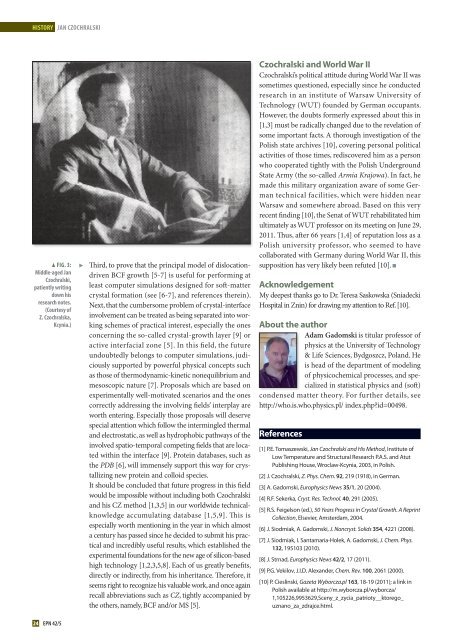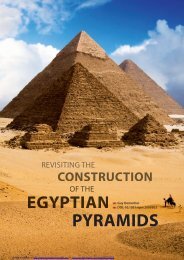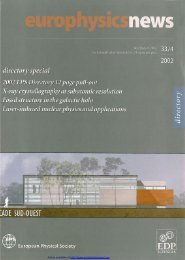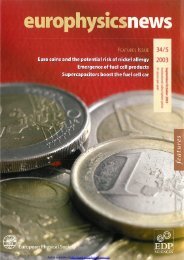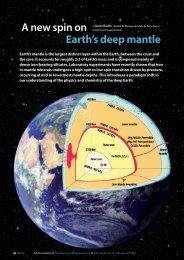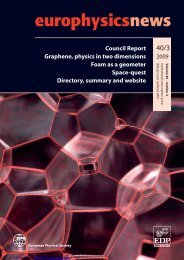PDF (11.37 MB) - Europhysics News
PDF (11.37 MB) - Europhysics News
PDF (11.37 MB) - Europhysics News
Create successful ePaper yourself
Turn your PDF publications into a flip-book with our unique Google optimized e-Paper software.
HiSTory Jan CZoCHralSKi<br />
� fig. 3:<br />
middle-aged Jan<br />
Czochralski,<br />
patiently writing<br />
down his<br />
research notes.<br />
(Courtesy of<br />
Z. Czochralska,<br />
Kcynia.)<br />
24<br />
EPN 42/5<br />
�<br />
�ird, to prove that the principal model of dislocationdriven<br />
BCF growth [5-7] is useful for performing at<br />
least computer simulations designed for so�-matter<br />
crystal formation (see [6-7], and references therein).<br />
Next, that the cumbersome problem of crystal-interface<br />
involvement can be treated as being separated into working<br />
schemes of practical interest, especially the ones<br />
concerning the so-called crystal-growth layer [9] or<br />
active interfacial zone [5]. In this field, the future<br />
undoubtedly belongs to computer simulations, judiciously<br />
supported by powerful physical concepts such<br />
as those of thermodynamic-kinetic nonequilibrium and<br />
mesoscopic nature [7]. Proposals which are based on<br />
experimentally well-motivated scenarios and the ones<br />
correctly addressing the involving fields’ interplay are<br />
worth entering. Especially those proposals will deserve<br />
special attention which follow the intermingled thermal<br />
and electrostatic, as well as hydrophobic pathways of the<br />
involved spatio-temporal competing fields that are located<br />
within the interface [9]. Protein databases, such as<br />
the PDB [6], will immensely support this way for crystallizing<br />
new protein and colloid species.<br />
It should be concluded that future progress in this field<br />
would be impossible without including both Czochralski<br />
and his CZ method [1,3,5] in our worldwide technicalknowledge<br />
accumulating database [1,5,9]. �is is<br />
especially worth mentioning in the year in which almost<br />
a century has passed since he decided to submit his practical<br />
and incredibly useful results, which established the<br />
experimental foundations for the new age of silicon-based<br />
high technology [1,2,3,5,8]. Each of us greatly benefits,<br />
directly or indirectly, from his inheritance. �erefore, it<br />
seems right to recognize his valuable work,and once again<br />
recall abbreviations such as CZ, tightly accompanied by<br />
the others, namely, BCF and/or MS [5].<br />
Czochralski and World War II<br />
Czochralski’s political attitude during World War II was<br />
sometimes questioned, especially since he conducted<br />
research in an institute of Warsaw University of<br />
Technology (WUT) founded by German occupants.<br />
However, the doubts formerly expressed about this in<br />
[1,3] must be radically changed due to the revelation of<br />
some important facts. A thorough investigation of the<br />
Polish state archives [10], covering personal political<br />
activities of those times, rediscovered him as a person<br />
who cooperated tightly with the Polish Underground<br />
State Army (the so-called Armia Krajowa). In fact, he<br />
made this military organization aware of some German<br />
technical facilities, which were hidden near<br />
Warsaw and somewhere abroad. Based on this very<br />
recent finding [10], the Senat of WUT rehabilitated him<br />
ultimately as WUT professor on its meeting on June 29,<br />
2011. �us, a�er 66 years [1,4] of reputation loss as a<br />
Polish university professor, who seemed to have<br />
collaborated with Germany during World War II, this<br />
supposition has very likely been refuted [10]. ■<br />
Acknowledgement<br />
My deepest thanks go to Dr. Teresa Saskowska (Sniadecki<br />
Hospital in Znin) for drawing my attention to Ref.[10].<br />
About the author<br />
Adam Gadomski is titular professor of<br />
physics at the University of Technology<br />
& Life Sciences, Bydgoszcz, Poland. He<br />
is head of the department of modeling<br />
of physicochemical processes, and specialized<br />
in statistical physics and (so�)<br />
condensed matter theory. For further details, see<br />
http://who.is.who.physics.pl/ index.php?id=00498.<br />
References<br />
[1] P.E. Tomaszewski, Jan Czochralski and His Method, Institute of<br />
Low Temperature and Structural Research P.A.S. and Atut<br />
Publishing House, Wroclaw-Kcynia, 2003, in Polish.<br />
[2] J. Czochralski, Z. Phys. Chem. 92, 219 (1918), in German.<br />
[3] A. Gadomski, <strong>Europhysics</strong> <strong>News</strong> 35/1, 20 (2004).<br />
[4] R.F. Sekerka, Cryst. Res. Technol. 40, 291 (2005).<br />
[5] R.S. Feigelson (ed.), 50 Years Progress in Crystal Growth. A Reprint<br />
Collection, Elsevier, Amsterdam, 2004.<br />
[6] J. Siodmiak, A. Gadomski, J. Noncryst. Solids 354, 4221 (2008).<br />
[7] J. Siodmiak, I. Santamaria-Holek, A. Gadomski, J. Chem. Phys.<br />
132, 195103 (2010).<br />
[8] J. Strnad, <strong>Europhysics</strong> <strong>News</strong> 42/2, 17 (2011).<br />
[9] P.G. Vekilov, J.I.D. Alexander, Chem. Rev. 100, 2061 (2000).<br />
[10] P. Cieslinski, Gazeta Wyborcza.pl 163, 18-19 (2011); a link in<br />
Polish available at http://m.wyborcza.pl/wyborcza/<br />
1,105226,9953629,Sceny_z_zycia_patrioty__ktorego_<br />
uznano_za_zdrajce.html.


